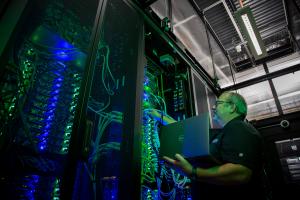In spring 2022, Michigan State University (MSU) received a grant from the National Science Foundation (NSF) to develop the Data Machine, a new research computing resource that could accommodate the analysis of large data sets, as well as artificial intelligence (AI) and machine learning work.
The project also strives to make high performance computing (HPC) more accessible to a wide range of disciplines, including the social sciences, that traditionally had not used it in research and in the classroom, said Brian O’Shea, a professor and director of the university’s Institute for Cyber-Enabled Research (ICER) who serves as principal investigator.

The co-investigators on the NSF grant represent the diversity of disciplines that can utilize HPC to advance their research and coursework, including spatial ecology, geography, mechanical engineering, earth sciences, computational science and chemical engineering. Academics in these areas have used the Data Machine for projects such as understanding large-scale ecological patterns and their drivers, turbulence modeling, examining the genomics of microbial communities, and analyzing real-time GPS and social media data to uncover broad behavioral patterns.
Implementation of Open OnDemand
ICER implemented the Ohio Supercomputer Center’s (OSC) Open OnDemand web portal on the Data Machine to provide a user-friendly interface to those in the campus community new to HPC. The university already had been using Open OnDemand extensively since 2020 on its existing HPC clusters.
“One of the things I have been trying to do as director of ICER is to make it easier for people to use research computing in scholarly work,” O’Shea said. “Open OnDemand is a keystone in broadening the use of research computing at MSU.”

ICER currently serves about 3,000 users, including faculty as well as a large number of graduate students and postdoctoral researchers. Many don’t want or need extensive HPC resources, O’Shea said, but struggle with trying to perform computations on personal laptops that may be several years old with insufficient memory to support the work. Onboarding them to the university’s resources, enhanced with the Open OnDemand interface, has helped more students and academics make the transition to HPC.
“Suddenly these people are much more productive because they can painlessly do these analyses on their local computers using the supercomputer as a platform,” O’Shea said. “They’re getting a lot of really good work done.”
ICER’s system administrators and facilitators are experienced with using Open OnDemand, including integrating it with commonly used apps and programs such as ArcGIS, Rstudio and Python. O’Shea and his colleagues also appreciate how easy it is to use containers on the portal to streamline software access.
“Containerization is very useful on Open OnDemand because you can customize the software and environment for whatever the principal investigator and students may need,” O’Shea said. “It gives us a huge amount of flexibility and makes things more robust. That is especially important for classes where instructors need uniformity.”
MSU also has benefitted from Open OnDemand’s recent integration of Globus, which supports the transfer and storage of large files for research, O’Shea added.
Advancing research computing at MSU
As the Data Machine is now open to users beyond the original grant-funded team of investigators, ICER is focused on promoting the university’s HPC resources and Open OnDemand to the broader academic community, including social sciences and humanities programs.
O’Shea is enthusiastic about the future of researching computing at MSU, as he envisions that researchers will increase their use of HPC resources—including for AI, machine learning and deep learning work—and that more instructors from a range of disciplines will integrate HPC into the curriculum.
“This helps us recruit and retain faculty who are doing innovative work, and tools like the Data Machine and Open OnDemand generally make it easier to include computation in a more diverse array of courses,” O’Shea said. “That’s important because it also lets us introduce students to computation as a tool earlier in their careers.”
Written by Andrea Gibson
The Ohio Supercomputer Center (OSC) addresses the rising computational demands of academic and industrial research communities by providing a robust shared infrastructure and proven expertise in advanced modeling, simulation and analysis. OSC empowers scientists with the services essential to making extraordinary discoveries and innovations, partners with businesses and industry to leverage computational science as a competitive force in the global knowledge economy and leads efforts to equip the workforce with the key technology skills required for 21st century jobs.